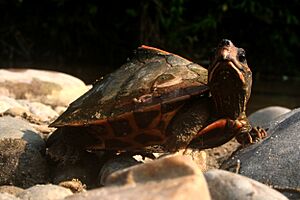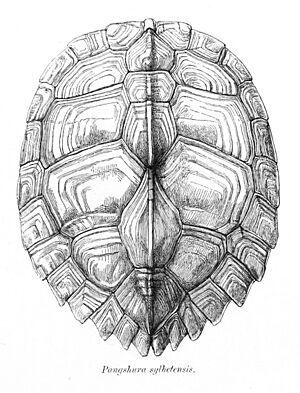Assam roofed turtle facts for kids
Quick facts for kids Assam roofed turtle |
|
|---|---|
 |
|
| Conservation status | |
| Scientific classification | |
| Genus: |
Pangshura
|
| Species: |
sylhetensis
|
| Synonyms | |
|
|
The Assam roofed turtle is also known as the Sylhet roofed turtle. Its scientific name is Pangshura sylhetensis. This special turtle belongs to the Geoemydidae family.
You can find this turtle in the Brahmaputra-Meghna river areas. These areas are in India (especially Assam) and parts of eastern Bangladesh.
Contents
About the Assam Roofed Turtle
This turtle has a unique shell, called a carapace. It looks like a triangle and is raised up. It also has a clear spike-like ridge down its back. The edge of its shell has 26 jagged plates.
The shell is usually olive brown. The ridge down its back is lighter, often yellowish or beige. The turtle has a small head with a slightly hooked upper jaw. A thin pink stripe runs from behind each eye to the back of its head.
Adult turtles can grow up to 20.5 centimeters long. However, most are around 16 centimeters in size.
Local people have different names for this turtle. In Assamese, it's called dura kaso (দূৰা কাছ). In Bengali, some names are śileṭi kaiṭṭa (সিলেটি কাইট্টা) or kãṭa kachim (কাঁটা কাছিম).
Where They Live
The Assam roofed turtle lives in northeastern and southeastern Bangladesh. It is also found in India (in Assam). There might even be some in Bhutan.
These turtles live both on land and in fresh water. They prefer areas with tropical forests in the uplands. You can find them in fast-flowing streams. They might also live in small rivers. Sometimes, they are found in oxbow lakes. However, their shell shape suggests they are best suited for fast-moving water.
Turtle Habits
The Assam roofed turtle can live both in water and on land. During the cooler, dry months, from December to February, they spend most of the day basking. Basking means they lie in the sun to warm up. Turtles in cooler hill streams might bask all year.
These turtles are quite shy. They never bask on river banks. Instead, they prefer to sunbathe on logs or rocks that stick out of the water. If they sense any danger, they quickly dive into the middle of the river. They hide among the rocks. Young turtles often hide in piles of dead leaves. This helps them blend in and stay still.
How They Reproduce
Assam roofed turtles lay their eggs between late October and February. This is during the cool, dry season. A female turtle usually lays 6 to 12 eggs at a time.
The baby turtles, called hatchlings, mostly appear between March and April. This is when the southeast monsoons begin. The eggs need to go through a special resting period. This period, called a diapause, happens at cooler temperatures. It lasts about 6 to 8 weeks for the eggs to hatch successfully.
Protecting the Turtle
The Assam roofed turtle is a very rare species. Only a few individuals have been seen. It is thought to have one of the smallest living areas of any turtle in South Asia.
This turtle faces many threats. People hunt it for its meat and eggs for food. It is also caught for the pet trade. In Asia, these turtles can be sold for very high prices as pets.
Their homes are also being destroyed by logging. Logging is when trees are cut down. Sometimes, they get caught by accident in fishing nets. All these things put the turtle in danger. Because of these threats, the IUCN has listed the Assam roofed turtle as critically endangered. This means it is at a very high risk of disappearing forever.



